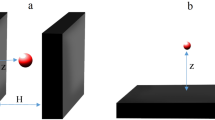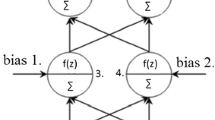Abstract
We present the results of mathematical modeling of quantitative relationship between the adsorption capacity of activated carbons and the partition coefficients of adsorbates in the n-octanol–water system. It has been found that the partition coefficients of adsorbates are highly informative descriptors in the mathematical models for prediction of the adsorption capacity of activated carbons. The empirical linear regression equation relating the similarity coefficients and the partition coefficients of adsorbates can be applied for the prediction tasks.
Similar content being viewed by others
References
Mukhin, V.M., Tarasov, A.V., Klushin, V.N., Aktivnye ugli Rossii (Active Coals of Russia), Moscow: Metallurgiya, 2000.
Roshchina, T.M., Soros. Obrazovat. Zh., 1998, no. 2, p. 89.
Plachenov, T.G., Pulerevich, M.Ya., and Frumin, G.T., Abstract of Papers, Nauchno-tekhnicheskaya konf. (Scientific and Technical Conference), Leningrad: LTI im. Lensoveta, 1962, p. 128.
Kel’tsev, N.V., Osnovy adsorbtsionnoi tekhniki (Basics of Adsorption Technology), Moscow: Khimiya, 1984.
Kuznetsov, B.N., Soros. Obrazovat. Zh., 1999, no. 12, p. 29.
Frumin, G.T., Ekologicheskaya toksikologiya. Kurs lektsii (Ecological Toxicology. Lecture Course), St. Petersburg: RGGMU, 2013.
Kolyshkin, D.A. and Mikhailova, K.K., Aktivnye ugli. Svoistva i metody ispytanii: spravochnik (Active Coals. Properties and Test Methods: Handbook), Leningrad: Khimiya, 1972.
Koul’, A.L. and Rizenfel’d, F.S., Ochistka gaza (Gas Cleaning), Moscow: Nedra, 1968.
Pavlov, K.F., Romankov, P.G., and Noskov, A.A., Primery i zadachi po kursu protsessov i apparatov khimicheskoi tekhnologii. Uchebnoe posobie dlya vuzov (Examples and Objectives for the Course of Processes and Devices of Chemical Technology. Textbook for Universities), Leningrad: Khimiya, 1987.
Stolyarov, E.A. and Orlova, N.G., Raschet fizikokhimicheskih svoistv zhidkosteii: Spravochnik (Calculation of Physico-Chemical Properties of Liquids: Handbook), Lenigrad: Khimiya, 1976.
Hansen, C.M., Hansen Solubility Parameters. https://doi.org/www.hansen-solubility.com.
Klesov, A.A. and Berezin, I.V., Fermentativnyi kataliz (Enzymatic Catalysis), Moscow: MGU, 1980.
Epshtein, N.A. and Nizhnii, S.V., Khim.-Farm. Zh., 1979, no. 3, p. 48.
Leo, A., Hansch, C., and Elkins D., Chem. Rev., 1971, vol. 71, no. 6, p. 92.
Komarov, V.S., Adsorbenty i ikh svoistva (Adsorbents and Their Properties), Minsk: Nauka i Tekhnika, 1977.
Frumin, G.T., Khim.-Farm. Zh., 1989, no. 1, p. 66.
Abramzon, A.A., Poverkhnostno-aktivnye veshchestva: Svoistva i primenenie (Surfactants: Properties and Applications), Leningrad: Khimiya, 1981.
Makarova, N.V. and Trofimets, V.Ya., Statistika v Excel (Excel Statistics), Moscow: Finansy i Statistika, 2002.
Dreiper, N., Smit, G., Prikladnoi regressionnyi analiz (Applied Regression Analysis), Moscow: Finansy i Statistika, 1986.
Tikhomirova, T.I., Doctoral (Chem.) Dissertation, Moscow, 2011.
Valvani, S.C., Yalkowsky, S.H., and Roseman, T.J., J. Pharm. Sci., 1981, vol. 70, no. 5, p. 502.
Dubinin, M.M., Fiziko-khimicheskie osnovy sorbtsionnoi tekhniki (Physico-Chemical Principles of Sorption Technology), Moscow: Gos. Khim.-Tekh. Izd., 1932.
Frolov, Yu.G., Kurs kolloidnoi khimii (Poverkhnostnye yavleniya i dispersnye sistemy): uchebnik dlya vuzov [The Course of Colloid Chemistry (Surface Phenomena and Disperse Systems): A Textbook for Universities], Moscow: Khimiya, 1982.
Author information
Authors and Affiliations
Corresponding authors
Additional information
Original Russian Text © G.T. Frumin, N.L. Bolotova, 2018, published in Ekologicheskaya Khimiya, 2018, Vol. 27, No. 4, pp. 221–228.
Rights and permissions
About this article
Cite this article
Frumin, G.T., Bolotova, N.L. Prediction of Sorption Capacity of Activated Carbons. Russ J Gen Chem 88, 2928–2933 (2018). https://doi.org/10.1134/S1070363218130169
Received:
Revised:
Accepted:
Published:
Issue Date:
DOI: https://doi.org/10.1134/S1070363218130169




